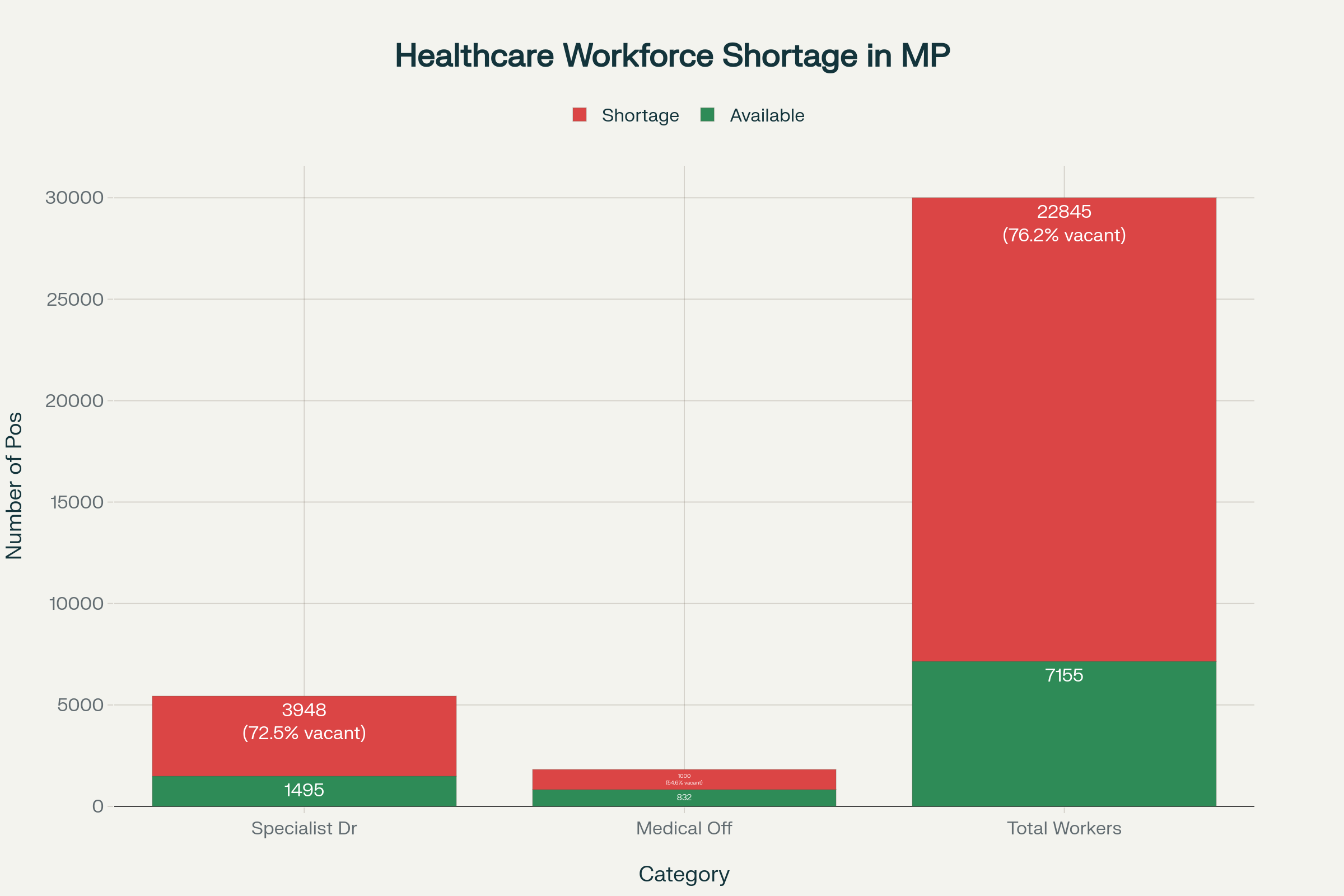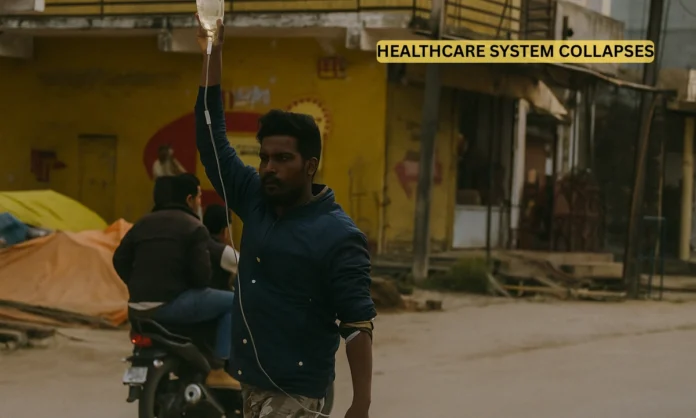Key Highlights
- Patient found walking in Sirsaud village market with IV drip after treatment by quack doctor who fled midway
- Madhya Pradesh faces 72.5% vacancy rate in specialist doctor positions with only 1,495 filled out of 5,443 sanctioned posts
- State healthcare system suffers from 22,845 vacant healthcare worker positions across all institutions
Viral Video Exposes Rural Healthcare Negligence
The disturbing footage capturing a man carrying a saline bottle while walking through Sirsaud village market with an IV needle inserted in his arm has sparked widespread outrage about the Madhya Pradesh healthcare crisis. Local residents confirmed that the patient received treatment from a quack doctor who inserted the drip and subsequently abandoned him during the medical procedure. Chief Medical and Health Officer Dr. Sanjay Risheshwar launched an immediate investigation, stating that if proven, this incident represents “serious negligence” requiring strict action against responsible parties.
जब इलाज मज़ाक बन जाए, तो बीमारी से ज़्यादा डर सिस्टम से लगने लगता है।
— RDX_💥_BABY (@RDXBABY11) November 1, 2025
झोलाछाप डॉक्टर ने मरीज को ही ड्रिप पकड़ाकर टॉयलेट करने भेज दिया।
आज देश के मरीज Road पर और स्वास्थ्य व्यवस्था ICU के बेड पर आराम कर रही है। pic.twitter.com/oPn8TI6mmi
- Investigation ordered by Chief Medical Officer into patient abandonment case
- Incident occurred in same district where newborn theft from hospital was recently reported
- Local community confirms treatment provided by unlicensed medical practitioner
- Video circulation highlights broader concerns about medical supervision standardss3.amazonaws
This episode represents one manifestation of Shivpuri district’s recurring healthcare failures, which have included multiple incidents ranging from missing infants to fake doctors operating without proper oversight within the broader Madhya Pradesh healthcare crisis. The district’s medical infrastructure has repeatedly failed to maintain basic patient safety and supervision standards required for quality healthcare delivery.

Doctor Shortage Crisis in Madhya Pradesh: Current Availability vs Required Numbers
Catastrophic Healthcare Workforce Shortage
The Madhya Pradesh healthcare crisis manifests most severely through critical workforce shortages, with the state requiring 89,000 doctors but having only 49,730 available, creating a concerning doctor-to-population ratio of 1:1,460. Recent government data reveals that specialist doctor positions face particularly devastating vacancy rates, with only 1,495 specialists working against 5,443 sanctioned posts, representing a staggering 72.5% vacancy rate.
- Anesthesiology specialists face 98% vacancy rate with only 10 doctors against 490 required positions
- Pediatrics departments operate with 68.9% vacancy rate across government hospitals
- General medicine, gynecology, and surgical specialties each face approximately 50% vacancy rates
- Total healthcare worker shortage reaches 22,845 vacant positions statewides3.amazonaws
The CAG audit report covering 2017-18 to 2021-22 exposed the magnitude of the Madhya Pradesh healthcare crisis, revealing systematic failures across healthcare infrastructure and human resources. Essential medical equipment including X-ray machines, diagnostic tools, and surgical instruments remain in critical shortage, while essential drugs for respiratory, cardiac, reproductive, and emergency care are frequently unavailable in district hospitals.

Healthcare Workforce Shortage Breakdown in Madhya Pradesh by Category
Medical Education and Faculty Crisis
The Madhya Pradesh healthcare crisis extends into medical education, where government medical colleges face severe faculty shortages that directly impact healthcare worker production. The Department of Medical Education has identified the need to create 291 Senior Resident posts across various government medical colleges to address faculty shortages affecting medical education quality.
- National Medical Commission requires minimum four senior residents per department
- Government medical colleges in Bhopal, Indore, Gwalior, Rewa, and other cities lack adequate senior residents
- PG students forced to seek private assistance for thesis completion due to faculty shortage
- Medical education quality deterioration contributes to ongoing healthcare worker scarcity
The faculty crisis perpetuates the Madhya Pradesh healthcare crisis by limiting the state’s capacity to produce qualified medical professionals. Dr. A.K. Shrivastava, Director of Medical Education, acknowledged that older medical institutions particularly lack senior resident positions, forcing postgraduate students to rely on private doctors for essential training components.
Healthcare Infrastructure and Disease Burden
| Health Indicator | Madhya Pradesh | National Average | WHO Standard |
|---|---|---|---|
| Doctor-Patient Ratio | 1:1,460 | 1:1,200 | 1:1,000 |
| Maternal Mortality Rate (per 100,000) | 173 | 103 | Under 70 |
| Infant Mortality Rate (per 1,000) | 52 | 30 | Under 25 |
| Rural Specialist Coverage | 6% | 20% | 80%+ |
| Healthcare Worker Shortage | 22,845 positions | Varies by state | Full coverage |
The Madhya Pradesh healthcare crisis is further complicated by emerging disease burdens, with chikungunya cases spiking dramatically in early 2025 to 113 cases, nearly matching dengue infections at 122 cases. This represents a concerning trend as the 113 chikungunya cases in just the first quarter approach the total number recorded in entire previous years, highlighting inadequate disease surveillance and vector control within the healthcare crisis.
- Chikungunya cases in Q1 2025 approach full-year totals from previous years
- Disease burden increases strain on already overwhelmed healthcare infrastructure
- Vector-borne disease control programs show insufficient effectiveness
- Public health gaps become more pronounced during disease outbreaks
Medical Specialist Shortage by Department
| Medical Specialty | Sanctioned Posts | Filled Posts | Vacant Posts | Vacancy Rate |
|---|---|---|---|---|
| Anesthesiology | 490 | 10 | 480 | 98.0% |
| Pediatrics | 958 | 298 | 660 | 68.9% |
| General Medicine | 850 | 425 | 425 | 50.0% |
| Gynecology | 720 | 360 | 360 | 50.0% |
| Orthopedics | 650 | 325 | 325 | 50.0% |
The data reveals that anesthesiology faces the most critical shortage within the Madhya Pradesh healthcare crisis, with 98% of positions vacant, severely limiting surgical capabilities across government hospitals. This shortage forces patients to seek expensive private healthcare or delay essential surgical procedures, exacerbating health outcomes and financial burdens on families.
Government Response and Investment Strategy
Recognizing the severity of the Madhya Pradesh healthcare crisis, the state government allocated Rs 4,418 crore for the National Health Mission in the 2025-26 budget, representing a 15% increase in healthcare spending. This substantial investment targets both urban and rural healthcare infrastructure development, including new Community Health Centers, Primary Health Centers, and Sub Health Centers throughout the state.
- Rs 1,277 crore designated for PM Ayushman Bharat Health Infrastructure Mission
- New medical colleges planned through public-private partnership model
- Substantial funding allocated for existing medical colleges in Ratlam, Datia, Shivpuri, and Satna
- Madhya Pradesh Public Service Commission contacted for filling 3,220 vacant medical positions
The government’s Health Sector Investment Promotion Policy 2025 outlines comprehensive strategies to address the Madhya Pradesh healthcare crisis through targeted interventions and infrastructure development. However, these initiatives must be accompanied by corresponding increases in qualified medical personnel recruitment and retention strategies to address underlying workforce shortages.
Long-term Impact Assessment of Healthcare Crisis
The viral IV drip patient incident serves as a powerful symbol of the systemic failures characterizing the Madhya Pradesh healthcare crisis, representing broader structural problems extending beyond individual negligence. This episode highlights how inadequate medical supervision, insufficient qualified practitioners, and weak regulatory enforcement create dangerous situations where patients become vulnerable to substandard care from unqualified providers.
The Madhya Pradesh healthcare crisis requires comprehensive solutions addressing workforce shortages, infrastructure gaps, and regulatory enforcement simultaneously. Until the state successfully implements systematic reforms including adequate healthcare worker recruitment, strengthened oversight mechanisms, and improved medical education capacity, vulnerable patients will continue facing risks from the healthcare system failures that enable incidents like the Shivpuri market episode.


